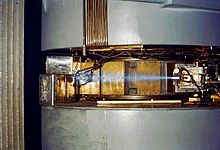Ionized-air glow



Ionized-air glow is the
Processes
When energy is deposited in air, the air molecules become excited. As air is composed primarily of
Deexcitation of nitrogen
The excited nitrogen deexcites primarily by emission of a photon, with emission lines in ultraviolet, visible, and infrared band:
- N2* → N2 + hν
The blue light observed is produced primarily by this process.[2] The spectrum is dominated by lines of single-ionized nitrogen, with presence of neutral nitrogen lines.
Deexcitation of oxygen
The excited state of oxygen is somewhat more stable than nitrogen. While deexcitation can occur by emission of photons, the more probable mechanism at atmospheric pressure is a chemical reaction with other oxygen molecules, forming ozone:[2]
- O2* + 2 O2 → 2 O3
This reaction is responsible for the production of ozone in the vicinity of strongly radioactive materials and electrical discharges.
Occurrence
Excitation energy can be deposited in air by a number of different mechanisms:
- Trinity nuclear test,[3][4][5][6] as well as Upshot-Knothole Annie,[citation needed] Operation Fishbowl,[7] and the Cherokee shot of Operation Redwing.[8][9]

- Within minutes after the steam explosion that caused the Alexander Yuvchenko, recounts that once he stopped outside and looked up towards the reactor hall he saw a "very beautiful" laser-like beam of light bluish light, caused by the ionization of air, that appeared to be "flooding up into infinity".[10][11]
- Cathode rays in air produce this blue glow.[12]
- Electrical discharge in air is the cause of blue light emitted by electric sparks, lightning, and corona discharges (e.g. St. Elmo's fire).
- Auroras, the sometimes observable blue-violet hues emitted by nitrogen at lower altitudes
Colors



In dry air, the color of produced light (e.g. by lightning) is dominated by the emission lines of nitrogen, yielding the spectrum with primarily blue emission lines. The lines of neutral nitrogen (NI), neutral oxygen (OI), singly ionized nitrogen (NII) and singly ionized oxygen (OII) are the most prominent features of a lightning emission spectrum.[13] Neutral nitrogen radiates primarily at one line in the red part of the spectrum. Ionized nitrogen radiates primarily as a set of lines in the blue part of the spectrum.[14]
A violet hue can occur when the spectrum contains emission lines of atomic hydrogen. This may happen when the air contains high amount of water, e.g. with lightnings in low altitudes passing through rain thunderstorms. Water vapor and small water droplets ionize and dissociate easier than large droplets, therefore have higher impact on color.[citation needed]
The
Ionized air glow vs Cherenkov radiation
The emission of blue light is often attributed to Cherenkov radiation.[8][verification needed] Cherenkov radiation is produced by charged particles which are traveling through a dielectric substance at a speed greater than the speed of light in that medium. Despite the production of similarity-colored light and an association with high-energy particles, Cherenkov radiation is generated by a fundamentally different mechanism.[citation needed]
See also
References
- ^ "Airglow". www.albany.edu. Retrieved 13 December 2021.
- ^ ISBN 0-12-352651-5.
- ^ Goodstein, David L.; Goodstein, Judith R. (2013). Robert F. Christy: 1916–2012 (PDF). Biographical Memoirs. National Academy of Sciences. p. 7.
- Nuclear Weapons Journal. No. 2. Los Alamos National Laboratory. 2005. p. 45. LALP-05-067. Retrieved 18 February 2014.
- ^ "Christy, Robert F. Interview by Sara Lippincott. Pasadena, California, June 15, 17, 21, and 22, 1994". Oral History Project, California Institute of Technology Archives. 1998. p. 55. Retrieved 5 August 2021.
- ^ Christy, Robert (6 July 2017). The Trinity Test: 'An eery and awesome sight' (9/20) (Video). Web of Stories - Life Stories of Remarkable People. Event occurs at 1'47". Archived from the original on 15 December 2021 – via YouTube.
- ^ Operation Dominic I: 1962 (PDF) (Report). Defense Nuclear Agency. p. 247. DNA 6040F.
- ^ OCLC 1109685186.
- ^ Bethge, Philip (25 November 2010). "Mushroom Clouds and Everpresent Danger: Surviving Cameramen Recall Nuclear Test Shots". Der Spiegel.
[Photographer George Yoshitake said] 'For several minutes after the blast, you could see this eerie ultraviolet glow high up in the sky. And I thought that was so spectacular, so meaningful.'
- ISSN 1818-2127. Archived from the original(PDF) on 11 December 2013.
- ISSN 0262-4079.
- ISBN 0-486-43875-9.
- ISBN 0-486-64575-4.
- ISBN 0-486-25237-X.
- .
- S2CID 250824737.
